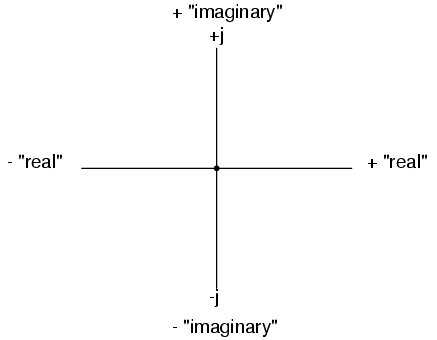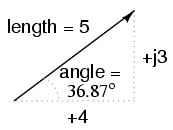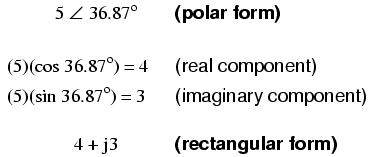Polar and rectangular notation
In order to work with these complex numbers
without drawing vectors, we first need some kind of standard
mathematical notation. There are two basic forms of complex
number notation: polar and rectangular.
Polar form is where a complex number is
denoted by the length (otherwise known as the
magnitude, absolute value, or modulus) and
the angle of its vector (usually denoted by an angle
symbol that looks like this: ∠). To use the map analogy,
polar notation for the vector from New York City to San
Diego would be something like "2400 miles, southwest." Here
are two examples of vectors and their polar notations:

Standard orientation for vector angles in AC
circuit calculations defines 0o as being to the
right (horizontal), making 90o straight up, 180o
to the left, and 270o straight down. Please note
that vectors angled "down" can have angles represented in
polar form as positive numbers in excess of 180, or negative
numbers less than 180. For example, a vector angled ∠ 270o
(straight down) can also be said to have an angle of -90o.
The above vector on the right (5.4 ∠ 326o) can
also be denoted as 5.4 ∠ -34o.

Rectangular form, on the other hand, is
where a complex number is denoted by its respective
horizontal and vertical components. In essence, the angled
vector is taken to be the hypotenuse of a right triangle,
described by the lengths of the adjacent and opposite sides.
Rather than describing a vector's length and direction by
denoting magnitude and angle, it is described in terms of
"how far left/right" and "how far up/down."
These two dimensional figures (horizontal
and vertical) are symbolized by two numerical figures. In
order to distinguish the horizontal and vertical dimensions
from each other, the vertical is prefixed with a lower-case
"i" (in pure mathematics) or "j" (in electronics). These
lower-case letters do not represent a physical variable
(such as instantaneous current, also symbolized by a
lower-case letter "i"), but rather are mathematical
operators used to distinguish the vector's vertical
component from its horizontal component. As a complete
complex number, the horizontal and vertical quantities are
written as a sum:


The horizontal component is referred to as
the real component, since that dimension is
compatible with normal, scalar ("real") numbers. The
vertical component is referred to as the imaginary
component, since that dimension lies in a different
direction, totally alien to the scale of the real numbers.
The "real" axis of the graph corresponds to
the familiar number line we saw earlier: the one with both
positive and negative values on it. The "imaginary" axis of
the graph corresponds to another number line situated at 90o
to the "real" one. Vectors being two-dimensional things, we
must have a two-dimensional "map" upon which to express
them, thus the two number lines perpendicular to each other:

Either method of notation is valid for
complex numbers. The primary reason for having two methods
of notation is for ease of longhand calculation, rectangular
form lending itself to addition and subtraction, and polar
form lending itself to multiplication and division.
Conversion between the two notational forms
involves simple trigonometry. To convert from polar to
rectangular, find the real component by multiplying the
polar magnitude by the cosine of the angle, and the
imaginary component by multiplying the polar magnitude by
the sine of the angle. This may be understood more readily
by drawing the quantities as sides of a right triangle, the
hypotenuse of the triangle representing the vector itself
(its length and angle with respect to the horizontal
constituting the polar form), the horizontal and vertical
sides representing the "real" and "imaginary" rectangular
components, respectively:


To convert from rectangular to polar, find
the polar magnitude through the use of the Pythagorean
Theorem (the polar magnitude is the hypotenuse of a right
triangle, and the real and imaginary components are the
adjacent and opposite sides, respectively), and the angle by
taking the arctangent of the imaginary component divided by
the real component:

-
REVIEW:
-
Polar notation denotes a complex
number in terms of its vector's length and angular
direction from the starting point. Example: fly 45 miles ∠
203o (West by Southwest).
-
Rectangular notation denotes a
complex number in terms of its horizontal and vertical
dimensions. Example: drive 41 miles West, then turn and
drive 18 miles South.
-
In rectangular notation, the first
quantity is the "real" component (horizontal dimension of
vector) and the second quantity is the "imaginary"
component (vertical dimension of vector). The imaginary
component is preceded by a lower-case "j," sometimes
called the j operator.
-
Both polar and rectangular forms of
notation for a complex number can be related graphically
in the form of a right triangle, with the hypotenuse
representing the vector itself (polar form: hypotenuse
length = magnitude; angle with respect to horizontal side
= angle), the horizontal side representing the rectangular
"real" component, and the vertical side representing the
rectangular "imaginary" component.
|